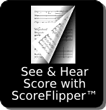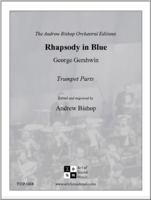Ein Heldenleben (Trumpet Parts)
| Arranger | Bishop, Andrew |
|---|---|
| Composer | Strauss, Richard |
| Duration | 50 |
| Ensemble | Trumpet |
| Genre | Classical |
| Grade | 4 |
| Model Number | TSSP-SEH |
| Category | Orchestral Trumpet Parts, Solo Trumpet |
This professionally re-engraved and transposed set of orchestral trumpet parts greatly eases learning and performance of the work. Available as PDF download or hard copy (9" x 12"). You can buy the parts individually or as a package:
- Trumpet 1 in C (doubles on B♭) (Originally Trumpet 1 in E♭)
- Trumpet 2 in B♭ (Originally Trumpet 2 in E♭)
- Trumpet 3 in C (Originally Trumpet 1 in B♭)
- Trumpet 4 in C (Originally Trumpet 2 in B♭)
- Trumpet 5 in C (Originally Trumpet 3 in B♭)
- Offstage Trumpets 3-5 in C
Notes from the Editor
This edition of Ein Heldenleben is intended to provide trumpet players with an updated, inconsistency-free, modern edition to use in both preparation and performance. There are minor changes from the original edition that I’ve made without comment (but were made after thorough research and careful contemplation), while the following updates warrant explanation.
1) The Trumpet parts are now listed as:
Trumpet 1 in C/B-flat (Originally Trumpet 1 in E-flat)
Trumpet 2 in B-flat (Originally Trumpet 2 in E-flat)
Trumpet 3 in C (Originally Trumpet 1 in B-flat)
Trumpet 4 in C (Originally Trumpet 2 in B-flat)
Trumpet 5 in C (Originally Trumpet 3 in B-flat)
I considered naming the original B-flat trumpet parts "Trumpets 1-3 "in this edition, since the E-flat trumpet parts are occasionally quite low, but decided to maintain the original score order of parts to avoid confusing music directors. Due to range, I've kept Trumpet 2 in B-flat, but C trumpet may be used when B-flat isn’t necessary.
2) All parts finally appear with proper enharmonic note spellings, with the following exceptions:
• Because Trumpet 2 is solely for B-flat trumpet, the section at reh. [83] would have required awkward spellings, so I simplified note spellings there.
• There are a few places where I retained “incorrect” enharmonic spellings when the alternative was going back and forth multiple times between a flat/sharp note and its natural.
3) There has been debate about what note Strauss intended on the third quarter note in the triplet at m. 670 in the Trumpet 3 (originally Trumpet 1 in B-flat) part. It appears in the score for B-flat trumpet as a written E-double flat (concert C), and written E-flat (C#) in the original trumpet part. I've decided to follow the score in my edition, showing a concert C in parenthesis. It would be prudent to discuss this with the music director before rehearsals to determine their wishes.
4) Dynamic shading between reh. [63] and [65] have been retained in the parts even though they do not appear in the score. This refers to any instance in this section where tied notes are reduced in dynamic by one level in the following measure. Even though the score does not indicate this practice, I feel that it makes musical sense, deferring to the more important moving passages while the trumpets remain static. This is another instance where performance tradition is retained.
5) The score doesn't have staccato markings on the fanfare figures in Trumpets 3-5 between reh. [58] and [62], but the original three parts did, albeit inconsistently between the parts. In this edition I decided to include them in the first two phrases, leaving the third without staccatos with the understanding that trumpet players know the tradition of how they are to be performed. (Additionally, there are a few other instances of missing/inconsistent articulation markings throughout the piece that have been remedied.)
6) Measure numbers have been added to all parts to aid in referencing passages amongst the trumpet players.
7) Some of the original cues deemed superfluous or generally unhelpful have been deleted, while other more appropriate and helpful cues have been added.
8) As is the problem with all Strauss tone poems, the general cramped nature of the original engraving has been revisited to a more reader-friendly spacing.
9) A separate three-stave score has been created for the off-stage section for Trumpets 3-5.
10) All parts have been reformatted to modern Concert 9×12 paper and should be printed accordingly.
The Andrew Bishop Orchestral Editions explore the concept of how these orchestral masterworks would appear if they were composed today. There are myriad differences in how music is currently published compared to when many of these works were originally engraved. “Tradition” is usually the (poor) excuse I hear when the topic of updating these masterworks is discussed – most often in reference to transposition(s). As a performer and teacher, I remain committed to the practice of honing vigorous transposition skills. However, there are many of these original engravings set in keys that are truly antiquated, and make almost no sense whatsoever to keep perpetuating. Transposition, however, is the least of the issues most of these original editions suffer from. Paper is no longer a premium and scarce product, and therefore the practice of cramming as much material on a page is not necessary. “Readability” was obviously not a concern with copyists of the times, and it is my opinion that the music suffered because of it. Therefore, a ”Bish Edish” (as they are popularly referred to) features many upgrades, including:
- Judicious spacing throughout the engraving (not too cramped, not too open)
- Correct enharmonic spellings of notes. This is an unfortunate byproduct of writing in asinine transpositions.
- A careful reconsidering of cue usage.
- Corrections of many inconsistencies between original parts and score, and even between parts themselves.
- The addition of measure numbers, including helpful ranges listed under multi-measure rests.
- Deleting key signatures and writing all parts utilizing accidentals only.
- All parts are formatted for standard Concert 9×12 paper, and is best printed on that size.
Reading it on 8.5×11 is not ideal, but the compression percentage isn’t too significant. Similarly, reading it off a larger tablet (e.g. iPad Pro) doesn’t present any significant issues.
In some instances, there are other upgrades specific to individual works that will be mentioned within the respective product. If you happen to find something questionable that you would like to bring to my attention, please feel free to do so at: trptshallsound@gmail.com. If it is something that I need to correct, I will be happy to do so and make sure you receive a corrected part/parts. If you have other works that you would like to have a custom edition made, please also reach out with that as well.
Andrew Bishop, Editor









